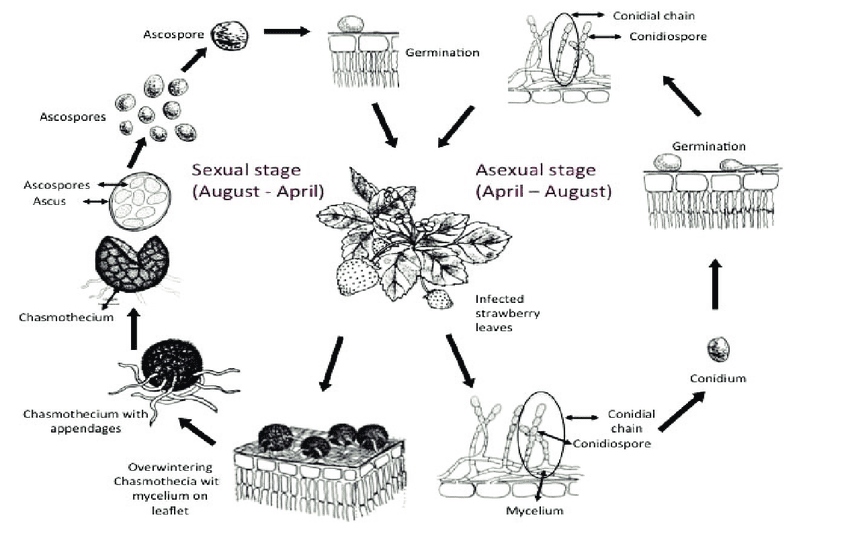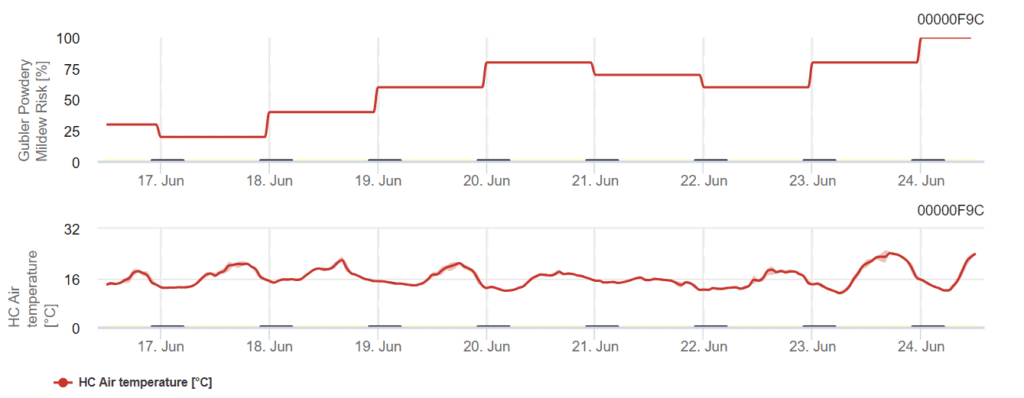
Strawberry disease models
Anthracnose
Pathogen
Anthracnose in strawberries, caused by Colletotrichum acutatum, manifests as black, sunken lesions on stems, runners, and fruits. This fungal disease affects all parts of the plant, including the crown, roots, petioles, and runners.
The disease can develop rapidly under favorable conditions with up to 90% of the fruit potentially infected within a week or less. Both immature and mature fruit are susceptible to infection, but the disease is most prevalent in ripening or fully mature fruit. Infected plants or plant debris can serve as sources of overwintering inoculum. In spring, spores and produced and dispersed by rain and wind over relatively short distances.
The pathogen enters the plant through an appressorium, which penetrates the cuticle and invades the epidermal cells. Initially, C. acutatum exists in a biotrophic phase and shifts to a necrotrophic phase, in which the fungus proliferates within the dead cells. As the disease progresses, the fungus forms acervuli structures beneath the epidermal cell walls. These acervuli mature and release conidia, which spread the disease more rapidly, especially under rain splash. Secondary conidia also serve as a significant inoculum source.
Symptoms
Symptoms first appear as wilting of the youngest leaves, which may temporarily recover but soon die. Irregular black spots emerge on leaves, especially at the tip of the leaflets.
The crown tissue then shows a reddish discoloration that eventually turns dark brown or black as the plant deteriorates. Infected crowns are often partially damaged, leading to stunted growth but not complete plant death. Typically, only one side of the crown becomes infected, rather than the entire crown.
Dark, elongated lesions form on the petioles and runner stems. The affected petioles and stems may become girdled by the lesions, causing the leaves or entire daughter plants to wilt and die.
Fruits can become infected at any stage of development, hardening and turning brown. Sunken, dark lesions develop on mature fruits, leading to mummification instead of ripening. The fruits may also appear to be covered in pink or salmon-colored masses of conidia.
FieldClimate Model
General Anthracnose Model
Sensors needed:
- Air temperature
- Leaf wetness
C. acutatum infects plants at the temperature range from 15°C to 30°C, but a long-lasting leaf wetness period is needed. At optimum temperatures of 20°C to 25°C, a leaf wetness period of 12 hours is necessary. When the infection graph reaches 100%, optimal conditions are given in the field for an infection.
Literature
- Aljawasim, B. D., Samtani, J. B., & Rahman, M. (2023). New Insights in the detection and management of anthracnose diseases in strawberries. Plants, 12(21), 3704.
- Ellis, M. A., & Erincik, O. (2008). Anthracnose of strawberry. The Ohio State University Extension.
- Smith, B. J. (2008). Epidemiology and pathology of strawberry anthracnose: a North American perspective. HortScience, 43(1), 69-73.
Powdery mildew
Pathogen

The pathogen for powdery mildew in strawberries is Podosphaera aphanis. It overwinters in two forms – mycelium and cleistothecia.
Overwintering mycelium becomes active in spring, producing conidiophores that release conidium (asexual reproductive spores) when mature. Conidia lands on a new tissue, germinates, and forms appressoria, specialized infection structures that penetrate plant cells. The process results in new colony formation.
Cleistothecia releases ascospores (sexual reproductive spores) from March to May. Ascospores also land on new tissues, germinate, and form new colonies.
Both mycelium and conidia serve as primary inoculum. Secondary infections mostly occur through conidia, which are dispersed by wind and spread rapidly.
When the environmental conditions become less favorable, the fungus shifts to sexual reproduction – cleistothecia formation – and the cycle repeats as the inoculums overwinter.
Symptoms
White powdery patches of mycelia and conidia appear on all aerial parts and coalesce, covering the entire surface. Young organs are more susceptible than older ones. Regarding leaves, the upperside exhibits greater powdery mildew than the underside. Severe infection causes reduced photosynthesis, defoliation, and fruit deformation. As the disease develops, the leaf curls upward, and purple to reddish blotches form on the leaf surfaces.
FieldClimate Models
Broome modified Gubler Model
Sensors needed:
- Air temperature
The model is based on the Gubler framework with modifications in high-temperature thresholds introduced by Broome. It calculates the risk with air temperature and the risk index ranges from 0 to 100. To trigger the index, three consecutive days with over 6 hours of temperatures between 21°C and 30°C are required.
The index increases by 20 points for each day that meets these conditions (a minimum of 6 hours at 21°C to 30°C). Conversely, if a day experiences less than 6 hours within this temperature range or if the temperature exceeds 35°C, the index decreases by 10 points.

The original Gubler model established a threshold of 35°C for 0.35 hours, but Broome has introduced several detailed high-temperature thresholds. When specific temperatures (34°C, 36°C, and 38°C) are met for sufficient duration, points are subtracted. Additionally, the model accounts for the delay in fungal growth; any index gain on the following day is delayed by several days and five extra points are deducted for each delayed day.
An index below 30 indicates a reproductive rate of 15 days or less, while an index of 40~50 is considered normal, implying a reproductive rate of 8 to 11 days. An index over 60 indicates that the pathogen is reproducing every 5 days and shortening the spray interval would be recommended.
Strawberry Powdery Mildew Model
Sensors needed:
- Air temperature
- Relative humidity
- Leaf wetness
This model includes leaf wetness and relative humidity to another model. Air temperatures above 21°C and relative humidity above 66% increase the risk while lower temperatures, relative humidity, and leaf wetness decrease the risk.
The risk index below 60 indicates plant protection measures on a low level while the risk above 60 indicates an increased disease risk and spraying would be recommended. Disease risks of 100 for a longer period require an increase in application density.
Literature
- Broome, J. C., Hand, E. K., Backup, P., Janousek, C. N., & Gubler, W. D. (2010, June). Revising the high temperature threshold for the Gubler-Thomas grape powdery mildew risk index. In PHYTOPATHOLOGY (Vol. 100, No. 6, pp. S17-S18). 3340 PILOT KNOB ROAD, ST PAUL, MN 55121 USA: AMER PHYTOPATHOLOGICAL SOC.
- Gadoury, D. M., Asalf, B., Heidenreich, M. C., Herrero, M. L., Welser, M. J., Seem, R. C., … & Stensvand, A. (2010). Initiation, development, and survival of cleistothecia of Podosphaera aphanis and their role in the epidemiology of strawberry powdery mildew. Phytopathology, 100(3), 246-251.
- Jin XiaoLei, J. X., Fitt, B. D. L., Hall, A. M., & Huang YongJu, H. Y. (2013). The role of chasmothecia in the initiation of epidemics of powdery mildew (Podospheara aphanis) and the role of silicon in controlling the epidemics on strawberry.
- Palmer, S. A. (2007). Strawberry powdery mildew: epidemiology and the effect of host nutrition on disease (Doctoral dissertation).
- Aldrighetti, A., & Pertot, I. (2023). Epidemiology and control of strawberry powdery mildew: a review. Phytopathologia Mediterranea, 62(3), 427-453.
Recommended equipment
Check which sensor set is needed for monitoring this crop’s potential diseases.
